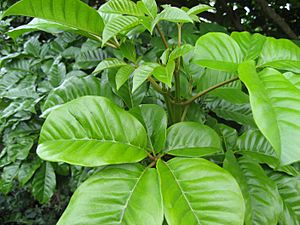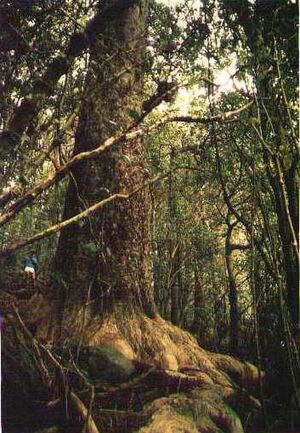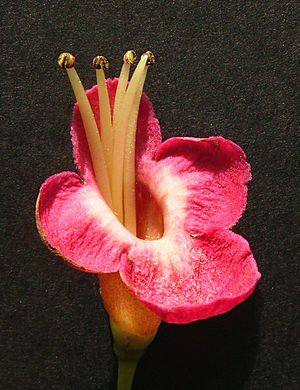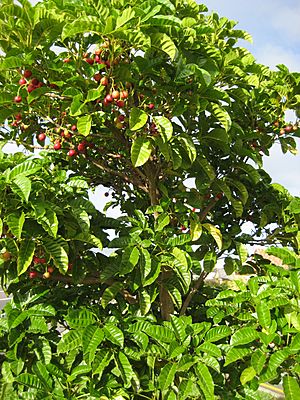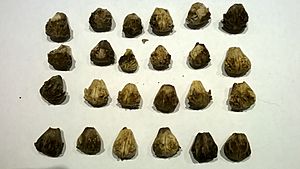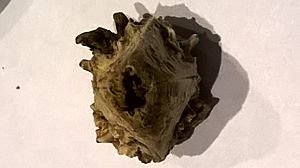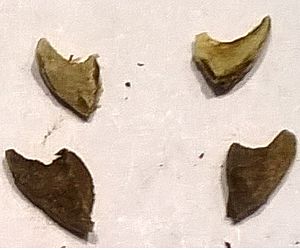Puriri facts for kids
Quick facts for kids Puriri |
|
|---|---|
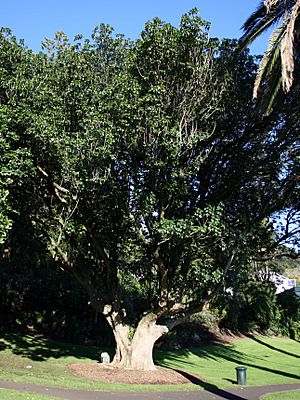 |
|
| Scientific classification | |
| Genus: |
Vitex
|
| Species: |
lucens
|
The Puriri (Vitex lucens) is a special evergreen tree that grows only in New Zealand. It's known for its strong wood and beautiful flowers.
Contents
Discovering the Puriri Tree
European explorers first found the puriri tree at Tolaga Bay in 1769. This was during Captain Cook's first trip to New Zealand. Two botanists, Joseph Banks and Daniel Solander, described the tree in detail.
Later, in 1826, another botanist named Allan Cunningham saw puriri trees growing near the Bay of Islands. He gave it the name Vitex littoralis. However, this name was already used for a tree in Malaysia. So, in 1897, Thomas Kirk gave the tree its current scientific name, Vitex lucens.
The Māori people have always known this tree as pūriri or sometimes kauere. In New Zealand English, it's usually called 'puriri'. Sometimes, older books might call its wood 'New Zealand mahogany' or 'New Zealand teak'.
What Does a Puriri Tree Look Like?
Puriri trees can grow very tall, up to 20 meters (about 65 feet). Their trunks can be quite wide, often 1.5 meters (5 feet) across, and they have a wide, spreading top. The bark is usually smooth and light brown, but it can also be flaky.
In the past, people cut down puriri trees for their wood. They often chose only the best, straightest trees. This is why many puriri trees you see today in fields look twisted and gnarled. But naturally, puriri trees can grow very straight and tall.
Leaves and Branches
The leaves of the puriri are dark green and shiny. They are palmate, which means they look like the palm of a hand with fingers spreading out. Usually, they have five leaflets, but sometimes only three. The two lowest leaflets are smaller than the others. If you look closely, you might see tiny pockets on the leaves where the veins meet. These pockets are called domatia and can house tiny creatures.
Young puriri branches are square-shaped. It's easy to mix up young puriri trees with another native tree called kohekohe. But remember, puriri leaflets all come from one point, while kohekohe leaflets are spread along the stem.
Flowers and Pollination
Puriri is one of the few native New Zealand trees with large, colorful flowers. Many other New Zealand plants have white or green flowers. Puriri flowers look a bit like snapdragon flowers. They can be bright pink, dark red, or even white with a hint of yellow or pink. Rose pink is the most common color.
These bright, tube-shaped flowers are perfect for birds to pollinate. They produce a lot of sweet nectar, and tiny hairs at the base of the flower stop insects from stealing it. Because there aren't always enough birds to drink all the nectar, puriri flowers on the mainland often have plenty of nectar left over.
Puriri flowers have four parts, four long male parts (called stamens), and a female part (called a style). The style grows longer after the pollen is released. The flowers grow in loose groups, with up to 12 flowers in each group.
Fruit and Seeds
You can find puriri flowers and ripe fruit on the tree all year round, though it flowers most in winter and fruits most in summer. This makes it a very important food source for native birds in the upper North Island, as it provides food when other trees might not. The flowers and fruit grow at the tips of the branches.
The fruit is usually bright red, but sometimes it can be pale yellow on trees with white flowers. It's about the size of a cherry, but it tastes a bit bitter. Inside the fruit is a very hard, pear-shaped nut. This nut can hold up to four seeds. The seeds from one nut might sprout all at once, or they might sprout over a whole year!
Where Puriri Trees Grow
Puriri trees are found only in New Zealand. They grow in the upper half of the North Island, from North Cape down to the Waikato area and Upper Thames. You can also find smaller numbers further south, to the Māhia Peninsula on the east coast and Cape Egmont on the west. They grow from sea level up to 800 meters (about 2600 feet) high.
Puriri trees often grow in rich, fertile, or volcanic soils. Early settlers would often burn areas with many puriri trees to clear the land for good farmland.
How Puriri Trees are Used
Important for Wildlife
Puriri is a super important food source for New Zealand's native animals. It provides fruit and nectar when many other plants don't. Because of this, puriri trees are often planted in areas where people are trying to bring back native forests. For example, they are planted at the Elvie McGregor Reserve and on Tiritiri Matangi Island.
Planting trees like puriri helps provide a steady food supply for birds all year. This helps bird populations grow. The puriri is especially helpful for increasing the number of kererū (native pigeons). Kererū are vital for spreading the seeds of other large-fruited trees, which helps the forest grow and stay healthy.
Puriri trees also provide homes for other creatures. The Puriri moth (or ghost moth) is New Zealand's largest and most amazing moth. Its caterpillars, which can be 10 cm long, often dig "7"-shaped tunnels in the puriri tree. The wide branches of the puriri also give space for other plants to grow on them, like Astelia, puka (Griselinia lucida), and Northern rātā (Metrosideros robusta).
Traditional Māori Uses
Māori people have used puriri in traditional medicine for hundreds of years. They would boil the leaves and use the liquid to treat sprains, backaches, ulcers, and sore throats. This liquid was also used to wash the bodies of people who had passed away, to help preserve them.
Sometimes, puriri trees or groves were considered tapu (sacred) because they were used as burial sites. Puriri leaves were also made into wreaths or carried during a tangi (funeral).
Puriri wood is usually dark greenish-brown, sometimes almost black, or streaked with yellow. Māori used it for tools and structures that needed to be strong and last a long time. Even though the wood was hard to carve because of its cross-grain, puriri garden tools and weapons lasted a long time. There's even a legend that says bullets would bounce off puriri fences! It was also used to make hinaki (eel traps) because it was one of the few woods that would sink in water. The sawdust from puriri can even dye flax fibers yellow.
The puriri provides the strongest wood in New Zealand. This made it perfect for making things like bridges and paddles.
Uses by European Settlers
European settlers used a lot of puriri wood for fence posts, railway sleepers, building ships, and house foundations. This is because the wood lasts for 50 years or more even when it's in the ground without any special treatment. Because of this, and because the soil where puriri grew was good for farming, many puriri forests were cut down. By the 1940s, there was very little puriri wood left.
Puriri wood was also popular for making furniture and decorative wood items, like fancy inlays. It was said to look as good as "the best Italian or American walnut." You can see examples of puriri furniture in old photos from places like New Zealand Geographic. The wood was sometimes called "New Zealand teak," "New Zealand oak," or "New Zealand walnut." The despatch boxes in the British House of Commons are made of puriri wood. They were a gift from New Zealand after the old ones were destroyed in 1941 during World War Two.
Modern and Future Uses
Today, you can sometimes find small amounts of puriri wood for sale, mostly around the Auckland and Northland areas. This wood is often used for wood-turning or recycled into garden furniture, like old puriri fence posts.
Experts suggest planting fast-growing, high-quality timber trees like puriri. This is because it's becoming more expensive to import special timbers, and native timber is scarce. Puriri wood is considered a "special-purpose species." This means it has unique qualities that make it better than Pinus radiata (a common plantation tree) for certain uses.
Puriri wood could be used again for furniture, veneers (thin layers of wood), turning (making bowls or spindles), outdoor woodwork, boat building, and tool handles. It could also be used for posts, wharf pilings, and bridge supports, as pine wood needs a lot of chemical treatment and can break easily. Puriri trees might also be good for producing biomass (plant material for energy) or charcoal, as they are one of New Zealand's most popular burning timbers.
See also
 In Spanish: Puriri para niños
In Spanish: Puriri para niños


